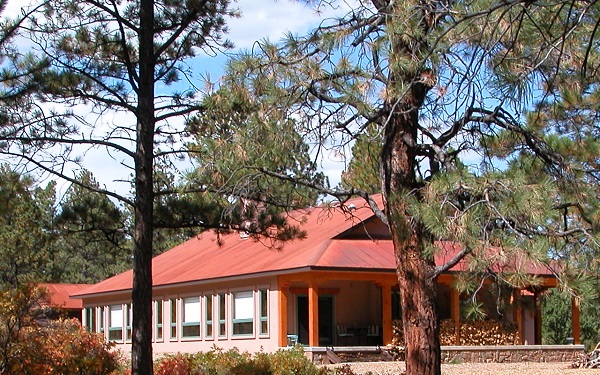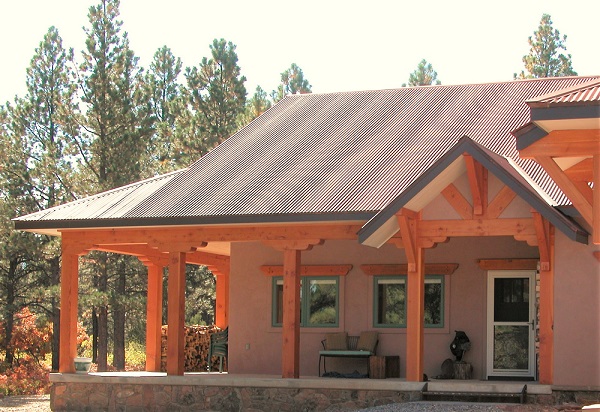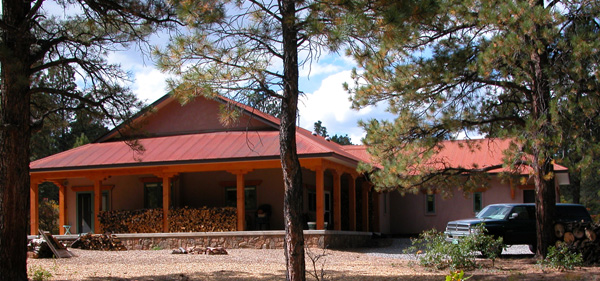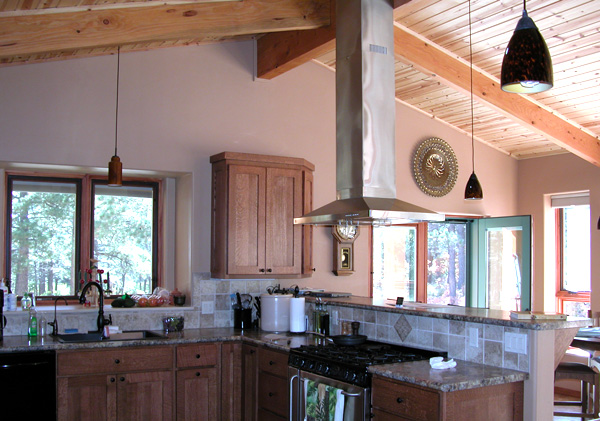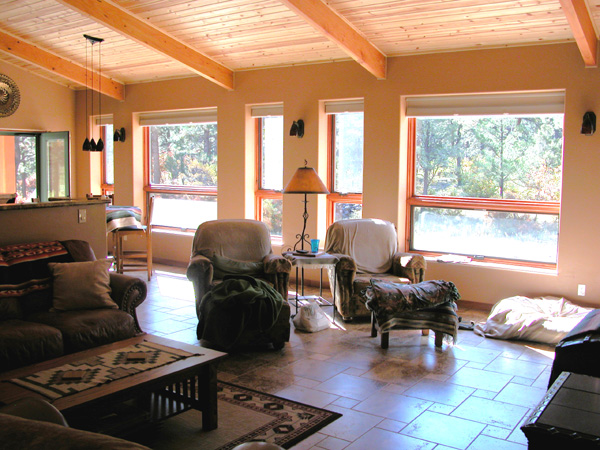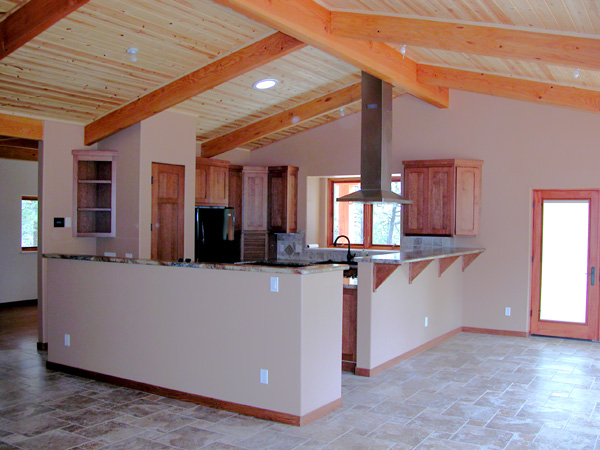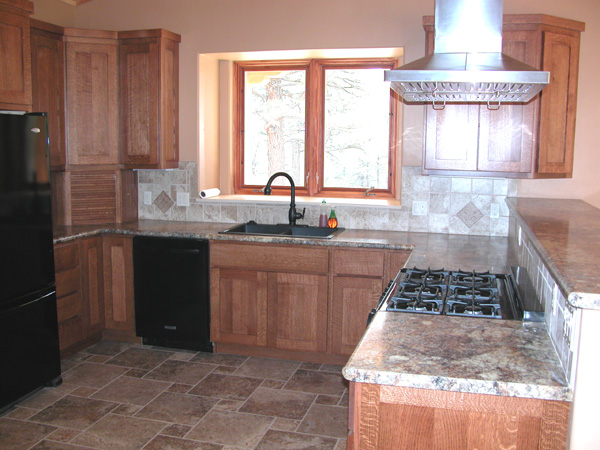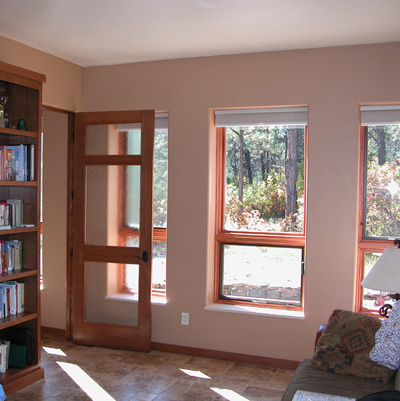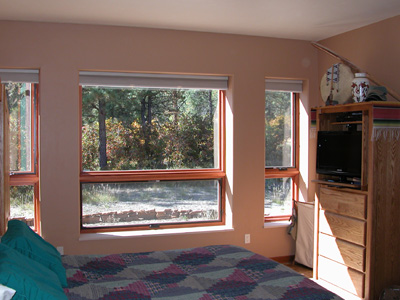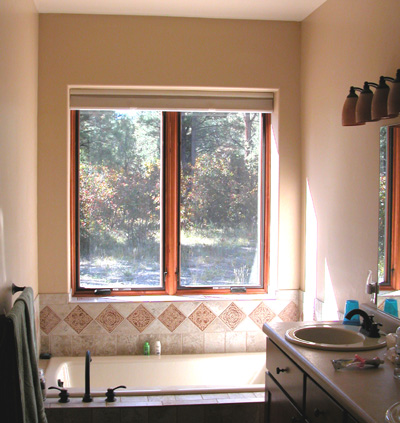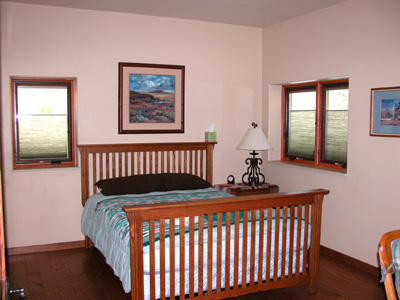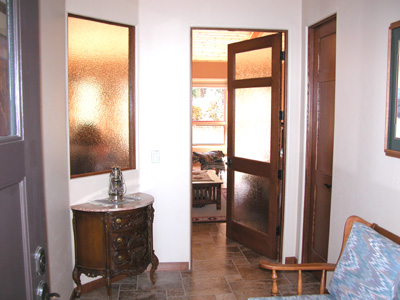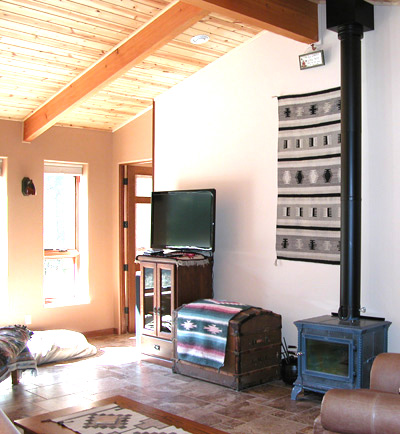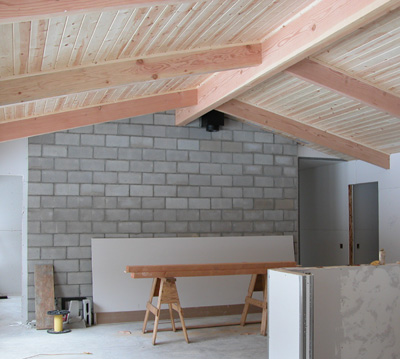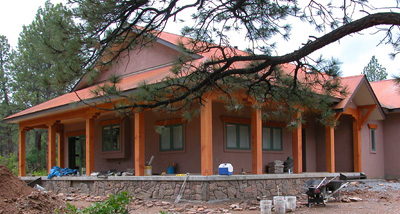HOUSE PLAN SPECS
Floor 1
2,447 sf
Entry Faces
North
South Glass
8%
Complexity
average
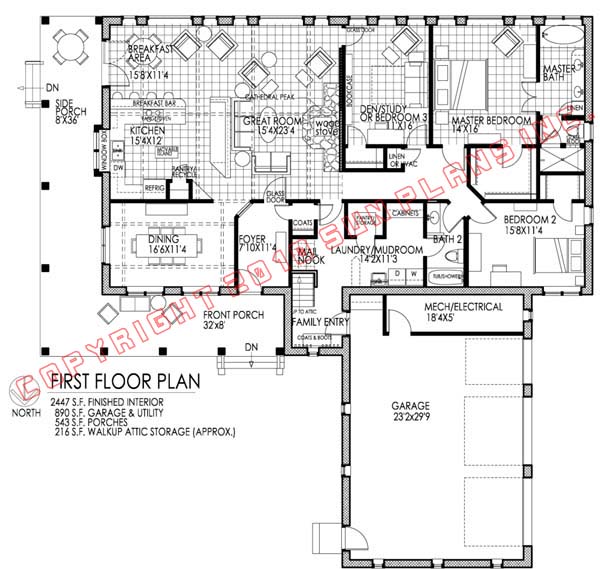
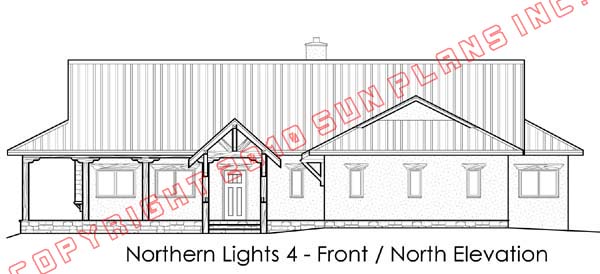
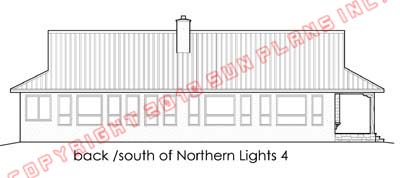
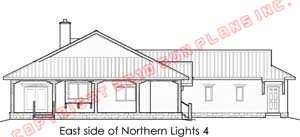
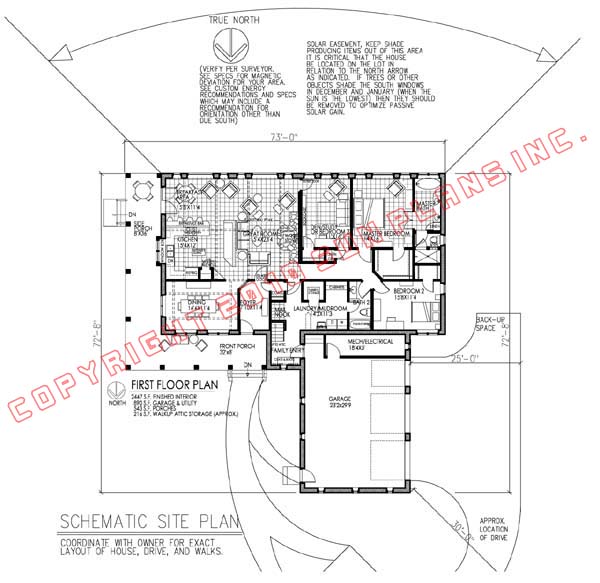
Northern Lights 4
PLAN PRICING
click anywhere to close...
Study Plans
See larger, clearer, and more drawings than what are shown on the individual house plan pages.
The price can be credited to future orders of Construction Prints or CAD Files of any Sun Plan even if a completely different house plan is later purchased.(Some exceptions if customer requires Study Plan level of consulting.)
Study Plans can be ordered from the Pricing tab for each house plan.
Study Plans include:
- A mini set of design-oriented drawings set up for 11"x17".
- A choice between a Paper version sent by US Priority Mail or the PDF version sent via email.
- Unlimited printing with PDF's for sharing with family members.
- 6 to 9 pages of drawings depending upon the complexity of the home.
- Click here to see an example set for a 1.5 story home with daylight basement.
- Schematic site plan, floor plans (with room sizes and furniture), daylight basements if applicable, exterior elevations, a schematic section of the house to help visualize the interior, kitchen elevations and garage plans.
click anywhere to close...
Review Sets
Review Sets provide information to help decide whether the design will meet the budget. They are mainly for those who crave technical details, have construction experience or have a builder on board.
The price can be credited to future orders of Construction Prints or CAD Files of any Sun Plan even if a completely different house plan is later purchased. (Some exceptions if customer requires Review Set level of consulting.)
Review Sets can be ordered from the Pricing tab for each house plan..
Review Sets include:
- A mini set of construction drawings set up for 11"x17"
- Choice of PAPER sent by US Priority Mail or PDF version sent via email. (Select PDF to print extra copies or share electronically with other building professionals.)
- 10 to 16 pages of drawings depending upon the complexity of the home.(See each house plan description for the drawings that come with each design.)
- Dimensions and construction notes.
- Click here to see an example Review Set of a 1.5 story home with daylight basement.
- A copy of the Study Plan.
- An "Opinion of Probable Construction Cost" from Sun Plans if requested. Sun Plans evaluates the design and compares it to similar home designs for which other clients have provided construction costs. A range of construction cost is provided. (This is based on national information. Sun Plans does not have statistics by state, region or country.)
Review Sets may vary slightly from later orders of Construction Prints and CAD Files since drawings are continuously being updated to meet newer construction and in-house standards,
click anywhere to close...
Construction Prints
Large Construction Prints with clear, concise information make it easy for builders to follow yet they are flexible enough to adapt locally based on the price and availability of materials and subcontractors, various construction methods and home owner preferences. Together, every builder and home owner will change some aspects of the design before or during construction. If mutually agreeable (and approved by the building inspector and local engineer), these "field changes" can often be made with red notes on the Construction Prints. (For complex changes, please see CAD Files or Adapt-A-SunPlan Services.)
Construction Prints include:
- Six sets of Construction Prints on 24"x36" paper shipped via UPS ground or PDF computer files sent by email
- 10 to 16 pages of drawings depending upon the size and complexity of the home. (See individual house plan descriptions for specific drawings for each design.)
- Schematic site plan (cover sheet showing how to orient the house for passive solar gain)
- Foundation Plan (either slab-on-grade, crawlspace, below grade or daylight basement)
- First and second floor plans (many construction notes, window sizes, etc.)
- Exterior elevations (all four sides shown in hatched detail)
- Schematic Building section (cut-away through the home showing basic configuration)
- Kitchen elevations (all sides of the kitchen)
- Typical wall detail (showing the various building materials recommended)
- Schematic electrical (showing lights, switches and outlets)
- Schematic framing plans (showing floor framing, roof framing and beams)
- Garage or Carport
- Custom Energy Specs. (Read more.)
- Under the Tell Me More about the Review Set, you can see an example set of drawings; however, with Construction Prints, the plans are updated to the current in-house checklist, do not have the Not For Construction, and include the Custom Energy Specs.
- One hour of technical support with the architect by email or phone
Miscellaneous Details
- Order Construction Prints through the Pricing tab on any house plan.
- After an order is placed, reply to the email received to advise of the requested information Sun Plans will need to prepare the Custom Energy Specs.
- Allow 5 business days for updating the design to the Sun Plans in-house checklist and preparation of the the Custom Energy Specs. (Shipping then takes another 3-7 days.)
- With PDF's, unlimited copies of the Construction Prints can be printed locally so long as they are used for building one home. PDF's are handy for sending to builders, mortgage companies, appraisers, home energy raters, and others who may be assisting with the planning and construction of the home such as the builder's subcontractors. Some building inspection departments require PDF.
Rick is in the lighting business and reviews construction prints in his work.
They are wonderful! If you saw most of the drawings and specifications I see, you would wonder how anything got built properly...It is just nice to see a true professional who does the job correctly and takes pride in her work. In my 34 years of working with Architects you are hands down the best I have had the privilege to work with. - Rick
A client sent a set of Construction Prints (designed for stick construction) to a SIP company to have them converted to SIPs. This is what they told the home owners:
I also wanted to take this opportunity to confirm your selection of Sun Plans Inc. We receive many sets of drawings each day that are interested in comparing SIPs. The drawings submitted by Sun Plans Inc. were high quality and very easy for us to work from. - Steve, SIPS of the South
click anywhere to close...
CAD Files
CAD files are the most flexible type of construction drawings since they can be modified and sent electronically. While the house design is intended to save the home owner energy, the CAD files are designed to save the energy of design professionals by making adaptations proceed faster should it be desired to have someone other than Sun Plans make the changes. The PDF files that are a part of the order allow for printing unlimited Construction Prints even if no changes are made. CAD files are intended to be used by professionals experienced in residential design.
CAD Files Include:
- CAD files of the Construction Drawings (see below for options)
- PDF file of the Construction Prints (see Construction Prints)
- PDF file of Custom Energy Specs
- PDF file of Copyright Release to allow the house to be modified and changed to build one house
- Under the Tell Me More about the Review Set, you can see an example set of drawings; however, with Construction Prints and CAD Files, the plans are updated to the current in-house checklist, do not have the Not For Construction, and include the Custom Energy Specs.
- One hour of technical support. This can include review by the Sun Plans' architect on proposed changes prior to preparing Custom Energy Specs. If the customer sends a list of proposed changes immediately after placing the order, the architect can review them for energy implications and try to address them in the Custom Energy Specs.
CAD File Details
- Order CAD files through the Pricing tab on any house plan.
- After an order is placed, reply to the email received to advise of the requested information Sun Plans will need to prepare the Custom Energy Specs.
- Allow 5 business days for to allow for updating the design to the Sun Plans in-house checklist and preparation of the the Custom Energy Specs.
- With the CAD files, many changes can be made to the design.
- With PDF's (part of the CAD file order), unlimited copies of the Construction Prints can be printed locally so long as they are used for building one home. PDF's are handy for sending to builders, mortgage companies, appraisers, home energy raters, and others who may be assisting with the planning and construction of the home such as the builder's subcontractors. Some building inspection departments require PDF.
- If consulting on changes is desired before the order is placed, then Adapt-A-SunPlan Consulting and Review Service is the process to take.
- The design professional may expand the house a couple of feet, change the exterior materials, move a bathroom, or rearrange interior walls and doors.
- The structural engineer may want to add engineering information such as rebar sizes and specific connections suitable for the local codes, soils, winds, snow or seismic activity.
- The builder may find it easier to perform take offs and layouts with this electronic version of construction prints.
- Home Energy Raters or HVAC subs creating duct work layouts can increase the speed and accuracy of their services.
Info for the Design Professional
- The CAD Files are designed to be used by an experienced residential design professional
- The standard method of preparing the CAD files is in AutoCAD 2000 DWG file type, with the files split into separate files. Approximately 95% of CAD file orders are prepared in this format. (Sun Plans can export to any version of AutoCAD between version 12 (released in 1992) and 2021, but 2000 is the default as that seems to be the most common one that design professionals can use including those with older versions of the software. It is not uncommon for other design professionals to use very old versions of AutoCAD.
- Can't use any of these CAD File types, but still want the local design professional to copy and redraw the design with changes? The Copyright Release that comes only with CAD Files allow for this. (Please see Copyright.)
- Special requests for all-in-one CAD files, DXF or AEC (DataCAD) files can be honored if advised within one business day of the order.
- Split CAD Files are divided into separate files - cover sheet, foundation, first floor, second floor, elevations, section, kitchen, wall detail, and detached garage as applicable. More than one of the printed sheet may be in each file. For instance, the fp1elect and fp1framing will also be in the fp1 file, but these are recommended to be printed separately as shown in the PDF files that come with the CAD Files.
- More questions? Have the design professional contact us.
click anywhere to close...
Mirror Reverse
Similar to the Mirror Reverse feature for each house plan, mirror reversing Construction Prints and CAD Files flips the house plan on the north-south axis. However, the Mirror Reverse custom service also reverses the text and numbers so that they are no longer backwards. The drawings will be "right reading". It takes some time to check for overlapping text and numbers, but it is a worthwhile service considering the errors that can be made by the builders and their subs if they otherwise tried to reverse the home during construction.
In rectangular plans designed with one long wall designed to face south, the south and north sides will still face the same compass direction, but the east and west walls are reversed. In angled plans designed to sit at a 45 degree angle to south, the mirror line is from the northern-most corner to the southern-most corner which is a diagonal line across the house. What was the northwest wall would then become the northeast wall, and what was the southwest wall would then become the southeast wall.
Instances of when reversing might help include when the home owners want the entry on the east rather than the west. Or maybe a bedroom on the west is desired instead of the east-facing bedroom if light is not wanted from the sunrise. There are hundreds of reasons for mirror reversing a house along the north-south axis. Sometimes the architect suggests it during the Review and Consulting phase of any custom services based on the home owners' site or other particulars.
A local design professional can also do the reversing with the CAD Files.
Mirror Reverse is a not available for the lower-priced Study Plans and Review Sets.
The Northern Lights 4 is an updated, rustic, high mass version of the original Northern Lights Sun Plan with its long-time proven energy performance. Timber columns, a front porch timber truss and wood lintels add western touches. Stacked stone blends the home to the land while the simple and practical stucco type coating is a natural and inexpensive siding for the ICF walls behind. The wrap-around front porch on the cool northeast side works especially well for those who enjoy shady summer evenings outside, but reversing the home would be recommended for those who preferred sunset viewing.
The house
is awesome. Warm in the winter and cool in the summer. I generally turn
the heat on for the season in mid-November and off in mid-March. We
might have a few cool mornings in the house before and after that, but
the wood stove warms it right up.- Kerry and Cheryl, Cold Climate
First Floor
From the front porch, a large airlock entry also serves as an art gallery with abundant wall space that is often missing in rooms that are open with lots of windows. A single glass door opens into the large earthy great room with wood ceilings and a large stone hearth. Next, the expanse of south windows is almost breathtaking. The kitchen is open to the sunny breakfast corner and the large great room. Its deep window box has enough room for several plants, but even the deep window sills in the south rooms can hold many flowers and herbs.
Two of the bedrooms will be sunny year-round while the northwest one may be the best choice for those who prefer less direct sun in winter. It may make a better office if computers or valuable books or art work are to be displayed.
Garage
The large garage has one small and two large overhead doors facing the side. The "L" shaped area forms a courtyard-like space for the front walkway. The separate mechanical room is nestled close to the house. The home is entered via the family entry large enough for boots and coats. The stairs up to the attic are designed to be nicely finished. Only after passing through the door at the top of the stairs, is the unfinished attic evident. The nearby laundry is ideally placed close to all bedrooms.
Construction Info
The great room, dining and breakfast have vaulted ceilings with beams dropped below the roof trusses. A wood ceiling here carries through with the rustic exterior of the home. In the dining area, dropped cross beams add elegance to the ceiling intended to have lighter white ceiling in between. The rest of the home has 9' high flat ceilings. Insulated concrete walls (ICF) and concrete floors throughout make this a very high mass home which keeps the temperatures very stable year-round. While the floors on the south side should be covered in stone, brick, tile or stained and polished concrete, the floors in the north rooms can be wood.
Modification Ideas
Since these ideas may affect energy performance and structural integrity, they should only be undertaken with professional assistance.
- Turn the dining area into a study or bedroom 4
- Make the ceilings all flat to allow for a walk-in attic and/or large entertainment area the entire width of the house
- Close off the laundry from the family entry
- Make 12" the walls double studs filled with blown insulation for a super energy-efficient wall system.
- Increase the south glass by making the windows taller
Construction Drawings
For this plan, the following are included with Construction Prints and CAD Files:
- Schematic Site Plan
- Slab On Grade Foundation
- Floor Plan including Attached Garage
- Exterior Elevations
- Building Section
- Kitchen Elevations
- Typical Wall Detail
- Schematic Electrical Plan
- Schematic Roof Framing
Comments and Photos
Thanks Kerry and Cheryl for sharing the lovely photos of the interior and exterior of your home!
They live off the grid in a cold climate.
"The house is awesome. Warm in the winter and cool in the summer. I generally turn the heat on for the season in mid-November and off in mid-March. We might have a few cool mornings in the house before and after that, but the wood stove warms it right up.
The solar panels provide all the power. I transitioned to all LED lights (now that the light quality is the same as incandescent) and that made a considerable difference in power consumption once the sun goes down.
Our backup generator will start about 6 times during the winter. Generally, after a few days of clouds/snow and generally when the well decides to come on the fill the cistern (our biggest power draw).
Favorite spots are probably the east porch, great place to get outside and enjoy coffee in the morning or a cocktail in the afternoon. It gets enough sun and is protected from the prevailing breeze such that anything above 40 degrees seems comfortable in the winter. Always cool and shady in the summer.
We like the open kitchen. The combination of the kitchen, great room, nook and counter are a gathering place that visitors seem to really enjoy. They would rather gather/stay/eat at the counter and nook rather than in the formal dining room. In the winter, the wood stove is a favorite in the great room. Interesting that if the sun has been out (even when its below zero outside) we sometimes can't start a fire at night, because it's just too warm in the house
Regarding fresh air: "We leave the master bath window and the window above the sink cracked open almost all year. It provides a nice flow of fresh air through the house." (Sun Plans comment, HRV's are generally recommended to provide fresh air into a home that will be sealed up most of the time.)
It amazes us how comfortable, efficient, and self-sustaining a house can be. Not sure why people continue to build the old-fashioned way. There outa be a law!!"
"The house is awesome. Warm in the winter and cool in the summer. I generally turn the heat on for the season in mid-November and off in mid-March. We might have a few cool mornings in the house before and after that, but the wood stove warms it right up.
The solar panels provide all the power. I transitioned to all LED lights (now that the light quality is the same as incandescent) and that made a considerable difference in power consumption once the sun goes down.
Our backup generator will start about 6 times during the winter. Generally, after a few days of clouds/snow and generally when the well decides to come on the fill the cistern (our biggest power draw).
Favorite spots are probably the east porch, great place to get outside and enjoy coffee in the morning or a cocktail in the afternoon. It gets enough sun and is protected from the prevailing breeze such that anything above 40 degrees seems comfortable in the winter. Always cool and shady in the summer.
We like the open kitchen. The combination of the kitchen, great room, nook and counter are a gathering place that visitors seem to really enjoy. They would rather gather/stay/eat at the counter and nook rather than in the formal dining room. In the winter, the wood stove is a favorite in the great room. Interesting that if the sun has been out (even when its below zero outside) we sometimes can't start a fire at night, because it's just too warm in the house
Regarding fresh air: "We leave the master bath window and the window above the sink cracked open almost all year. It provides a nice flow of fresh air through the house." (Sun Plans comment, HRV's are generally recommended to provide fresh air into a home that will be sealed up most of the time.)
It amazes us how comfortable, efficient, and self-sustaining a house can be. Not sure why people continue to build the old-fashioned way. There outa be a law!!"
When asked about temperatures and comfort,they responded:
"...we had several record days above 90 and that resulted in the highest temperature we have ever seen inside. During that hot spell, we saw the inside temperature reach 78 degrees.
We bought some really expensive window coverings for the south windows Turns out we almost never use them. In the summer, the sun is above the soffits and the house stays cool. (Sun Plans comment: that means the south windows were in shade.)
In the winter, we generally drop the coverings if we know the temperature will drop to around zero or below outside. Otherwise we don't use them. We only see a few degree drop in internal temperature overnight, I believe because of the stored heat coming from the floor and thermal wall. In the dead of winter, when the sun angle is low and sunlight is reaching well into the house on a sunny day, we have seen 75 degrees inside. We just crack a few windows or open a door. It feels great when it's below zero outside with 2 or 3 feet of snow on the ground and we can stay in the 70's with the heating system off.
I have the heat system come on at 5 AM and is set to 68 degrees. I have the heat system turn off at 9 AM. If the sun is out, it raises the temperature and takes care of keeping the house warm the rest of the day. If no sun, we use the wood stove. We installed a hybrid Hearthstone stove with cast iron frame and soapstone sides and top (I would recommend the stove to anyone). 1 or maybe 2 loads of wood will heat the house for the day. Other than the great room and hallway, I have all other heat zones turned off unless we leave for a period or have visitors / use the dining room." - Kerry and Cheryl
"...we had several record days above 90 and that resulted in the highest temperature we have ever seen inside. During that hot spell, we saw the inside temperature reach 78 degrees.
We bought some really expensive window coverings for the south windows Turns out we almost never use them. In the summer, the sun is above the soffits and the house stays cool. (Sun Plans comment: that means the south windows were in shade.)
In the winter, we generally drop the coverings if we know the temperature will drop to around zero or below outside. Otherwise we don't use them. We only see a few degree drop in internal temperature overnight, I believe because of the stored heat coming from the floor and thermal wall. In the dead of winter, when the sun angle is low and sunlight is reaching well into the house on a sunny day, we have seen 75 degrees inside. We just crack a few windows or open a door. It feels great when it's below zero outside with 2 or 3 feet of snow on the ground and we can stay in the 70's with the heating system off.
I have the heat system come on at 5 AM and is set to 68 degrees. I have the heat system turn off at 9 AM. If the sun is out, it raises the temperature and takes care of keeping the house warm the rest of the day. If no sun, we use the wood stove. We installed a hybrid Hearthstone stove with cast iron frame and soapstone sides and top (I would recommend the stove to anyone). 1 or maybe 2 loads of wood will heat the house for the day. Other than the great room and hallway, I have all other heat zones turned off unless we leave for a period or have visitors / use the dining room." - Kerry and Cheryl
